On one side the hardware store, on the other the Wupper and drizzle from above. In between, the landmark of Wuppertal-Heckinghausen towers into the sky: a 70 meter high gas boiler. There hasn't been any fuel in there for a long time. The restaurant and gym have moved in, and there are 33 projectors under the roof, plus Europe's largest 360-degree screen: the so-called Visiodrome. Powerful speakers are apparently also part of the inventory. Music can be heard outside through the steel casing.
However, the main role is not played by the music, but by the art of Claude Monet, title of the show: "Monet - Rebel and Genius". The Visiodrom presents one of those immersive exhibitions that are currently booming.
The term immersion comes from Latin and means "immerse" or "embed". Films can be immersive, taking viewers into strange worlds. But you experience them passively. Today, the term immersion is often related to virtual reality. This technology makes it possible for the viewer to interact with the artificial environment and, in some cases, to immerse themselves so deeply that they perceive the virtual as real.
In NRW, immersive Van Gogh shows recently stopped in Cologne and Mülheim an der Ruhr. Dortmund lets visitors immerse themselves in the art of Klimt and Hundertwasser in the newly opened "Phoenix des Lumières".
And in Wuppertal, those interested are still queuing up for Monet until April, even if not a single original can be seen. The view of the multimedia all-round experience is enough - of gigantic haystacks and cathedrals, of shimmering rivers, moving trees and enchanting water lilies. More than 250 works are not just shown, but performed to a certain extent.
This time, however, only in 27 minutes and 54 seconds. As long as the countdown is running, you wait downstairs in the cool cauldron for the next performance. Illustrated information boards provide information about Monet's life and work.
The Visiodrom was able to win over Gerhard Finckh for the art historical part of the spectacle. A name that is popular in Wuppertal, where Finkch successfully managed the Von der Heydt Museum for many years and set visitor records with a Monet exhibition in 2009 – 300,000 came at the time. The 100,000th guest is expected in the Visiodrom in February.
On weekends, the grandstands should be densely occupied. But on this cloudy afternoon there is plenty of room. The journey into Monet's world starts with pictures of railways. Historical photos are mixed in with the moving flood of images in giant format, accompanied by loud music. Trains roll, clouds roll, flower petals swirl in the wind, a little boat cruises on the Seine.
However, the story behind it can only be understood with a little prior knowledge. It gets wintry when Monet's wife Camille dies. Towards the end of the performance, the famous water lilies from Monet's garden at Giverny can be seen circling the walls. Dizziness, amazement, overwhelm.
Sure, his well-known motifs are there, but does this type of treatment do Monet's art justice? Is this show a meaningful way of art education? Questions that also arise in Dortmund in the former Phoenix-West blast furnace plant, whose more than 2000 square meter gas blower hall has been expanded into a place for immersive exhibitions.
Behind it is Culturespaces - a French company that has been installing digital art centers all over the world for several years. It all started in Paris in 2018, followed by Dubai, New York, Amsterdam and Seoul, among others. Now it's Dortmund's turn and soon Hamburg. The program includes audience favorites such as Cézanne and "The Lights of Provence", Kandinsky and "The Odyssey of Abstraction" and also Dalí - "The Endless Mystery".
As an art historian and museum man, how does Gerhard Finckh assess the triumph of immersion? "I think it's an interesting new form of presentation, and it's exciting to me what you can do with it," he says.
The churches of the baroque are comparable in their conception as a total work of art that is as touching as possible, says Finckh. The church artists of yore worked with spatial illusions, incorporating the light falling through the stained church windows.
However, the masters of the baroque also considered the overwhelming as a stylistic device and planned their total work of art themselves. Comparable with colleagues today who consciously work with immersion as an art form.
Completely different with masters like Monet, Klimt or Klee, for whom it would have been incomprehensible what was happening, for example, in the Dortmund Klimt show: Painted trees seem to grow out of the ground, meadows of flowers burst the picture and overgrow the walls. Gold dust swirls around portraits, shiny plates trickle to the ground like confetti. Individual image motifs, duplicated umpteen times, conquer the huge space.
For Finckh, such immersion shows have a right to exist because they could also attract visitors who might not have gone to the museum. In fact, the effect is unmistakable in the Phoenix Hall and also in the Visiodrome: amazed people stroll devoutly through Klimt's pictorial worlds or remain fascinated in beanbags to watch Monet paint. You don't need to know anything about Impressionism or Vienna around 1900.
But what if they actually jump out of the beanbag – enthusiastic about the bright, moving, bombastic series of images – to look for the originals in the museum? Will they be overwhelmed by the authentic brushstrokes or will they be disappointed by the comparatively small format hanging quietly on the wall? That doesn't impose itself, but wants to be discovered. "It's just two different things," says Finckh. Only the original shows what the artist wanted – everything else is an interpretation, an ingredient.
For Harald Opel from the University of Applied Sciences in Dortmund, immersive exhibitions are “great entertainment”. However, with his research project “page 21” he is taking a different approach. To this end, he has teamed up with two museums and set up a small room in the foyer of the Dortmunder U. Here the visitor moves as if he had VR glasses in front of his eyes - the room reacts to his movements.
But Opel considers the content even more important than the complex technology: "We don't try to dissolve or dissect the work of art," he explains. “We want to place it in other contexts and build new stories around the works.” For example, a picture by Paula Modersohn-Becker that shows herself with a baby in her arms – an unfulfilled dream of the artist to have children.
This work is set in heavenly realms, where the artist enters into a fictitious dialogue with the child. One moves in space with Modersohn-Becker. Opel sees the future in such immersive storytelling: "Something that doesn't replace museums, but creates added value."

 Sydney: Assyrian bishop stabbed, conservative TikToker outspoken on Islam
Sydney: Assyrian bishop stabbed, conservative TikToker outspoken on Islam Torrential rains in Dubai: “The event is so intense that we cannot find analogues in our databases”
Torrential rains in Dubai: “The event is so intense that we cannot find analogues in our databases” Rishi Sunak wants a tobacco-free UK
Rishi Sunak wants a tobacco-free UK In Africa, the number of millionaires will boom over the next ten years
In Africa, the number of millionaires will boom over the next ten years Can relaxation, sophrology and meditation help with insomnia?
Can relaxation, sophrology and meditation help with insomnia? WHO concerned about spread of H5N1 avian flu to new species, including humans
WHO concerned about spread of H5N1 avian flu to new species, including humans New generation mosquito nets prove much more effective against malaria
New generation mosquito nets prove much more effective against malaria Covid-19: everything you need to know about the new vaccination campaign which is starting
Covid-19: everything you need to know about the new vaccination campaign which is starting For the Olympics, SNCF is developing an instant translation application
For the Olympics, SNCF is developing an instant translation application La Poste deploys mobile post office trucks in 5 rural departments
La Poste deploys mobile post office trucks in 5 rural departments Meta accelerates into generative artificial intelligence with Llama 3
Meta accelerates into generative artificial intelligence with Llama 3 In China, Apple forced to withdraw WhatsApp and Threads applications at the request of the authorities
In China, Apple forced to withdraw WhatsApp and Threads applications at the request of the authorities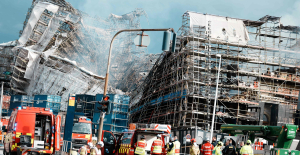 The main facade of the old Copenhagen Stock Exchange collapsed, two days after the fire started
The main facade of the old Copenhagen Stock Exchange collapsed, two days after the fire started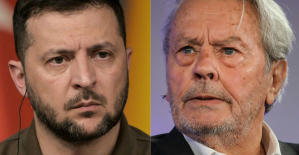 Alain Delon decorated by Ukraine for his support in the conflict against Russia
Alain Delon decorated by Ukraine for his support in the conflict against Russia Who’s Who launches the first edition of its literary prize
Who’s Who launches the first edition of its literary prize Sylvain Amic appointed to the Musée d’Orsay to replace Christophe Leribault
Sylvain Amic appointed to the Musée d’Orsay to replace Christophe Leribault Skoda Kodiaq 2024: a 'beast' plug-in hybrid SUV
Skoda Kodiaq 2024: a 'beast' plug-in hybrid SUV Tesla launches a new Model Y with 600 km of autonomy at a "more accessible price"
Tesla launches a new Model Y with 600 km of autonomy at a "more accessible price" The 10 best-selling cars in March 2024 in Spain: sales fall due to Easter
The 10 best-selling cars in March 2024 in Spain: sales fall due to Easter A private jet company buys more than 100 flying cars
A private jet company buys more than 100 flying cars This is how housing prices have changed in Spain in the last decade
This is how housing prices have changed in Spain in the last decade The home mortgage firm drops 10% in January and interest soars to 3.46%
The home mortgage firm drops 10% in January and interest soars to 3.46% The jewel of the Rocío de Nagüeles urbanization: a dream villa in Marbella
The jewel of the Rocío de Nagüeles urbanization: a dream villa in Marbella Rental prices grow by 7.3% in February: where does it go up and where does it go down?
Rental prices grow by 7.3% in February: where does it go up and where does it go down? With the promise of a “real burst of authority”, Gabriel Attal provokes the ire of the opposition
With the promise of a “real burst of authority”, Gabriel Attal provokes the ire of the opposition Europeans: the schedule of debates to follow between now and June 9
Europeans: the schedule of debates to follow between now and June 9 Europeans: “In France, there is a left and there is a right,” assures Bellamy
Europeans: “In France, there is a left and there is a right,” assures Bellamy During the night of the economy, the right points out the budgetary flaws of the macronie
During the night of the economy, the right points out the budgetary flaws of the macronie These French cities that will boycott the World Cup in Qatar
These French cities that will boycott the World Cup in Qatar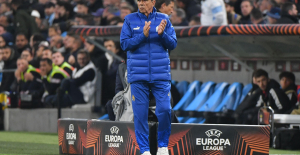 Europa League: “We dream of everything,” says Jean-Louis Gasset
Europa League: “We dream of everything,” says Jean-Louis Gasset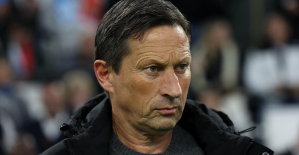 Europa League: “Trouble playing our football,” admits Benfica coach
Europa League: “Trouble playing our football,” admits Benfica coach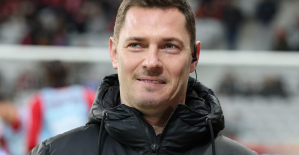 Europa League Conference: “Martinez eats all your deaths”, Obraniak’s breakdown after the elimination of Lille
Europa League Conference: “Martinez eats all your deaths”, Obraniak’s breakdown after the elimination of Lille Premier League: “It’s a team that is transforming into the Champions League”, Casemiro returned to Real’s qualification
Premier League: “It’s a team that is transforming into the Champions League”, Casemiro returned to Real’s qualification


















